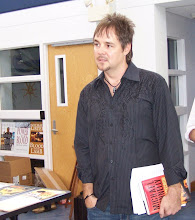
Fashion designer Tom Ford’s directorial debut of Christopher Isherwood’s novel, “A Single Man” is a faithful, yet artistic, adaptation, and ultimately an extraordinary film. Financed by Ford himself, this stylistic work of art affords Colin Firth the role of a lifetime.
Set in Los Angeles on November 30, 1962, “A Single Man” is the story of George Falconer (Colin Firth), a middle-aged British college professor who has struggled to find meaning in his life since the sudden death eight months earlier of his longtime partner, Jim (Matthew Goode). Throughout the single day depicted in the film, and narrated from his point of view, George dwells on his past and his seemingly empty future as he prepares for his planned suicide that evening. Before meeting his close friend Charley (Julianne Moore) for dinner, he has unexpected encounters with a Spanish prostitute (Jon Kortajarena) and a young student, Kenny Potter (Nicholas Hoult), who has become fixated on George as a kindred spirit.
You’d expect a designer like Ford to make pretty pictures of pretty people wearing pretty closes standing in pretty places, but unlike so many music video directors who are unable to combine beautifully shot images and symbols into narrative, Ford integrates style and substance in brilliant, effective, and evocative ways.
“A Single Man” is about, among other things, being single, and as I watched the frames unspool and bathe the enormous screen, I began to think about what this means. In one sense, we’re all single. In another, none of us are. When most people think of being single, they think of someone who has no sexual partner, no primary person, no automatic plus-one for every situation that calls for it. Of course, many, if not most, still equate this with marriage. One is single until one is married. But there are plenty of single married people; plenty of people who are not married and couldn’t be less single.
Interestingly, George doesn’t just appear to be single now that Jim is dead, but because their relationship is rejected by society, he appeared to be so even when Jim was alive and they were together. This is true of all secret or non-sanctioned relationships—which, at various times and in various places, have included race, religion, sex, age, family, nationality, number of partners, sexual orientation, etc.
George is an acutely single man in the sense that he isn’t allowed to truly grieve for his great love because family and friends and coworkers and the community don’t recognize the relationship, don’t value Jim and George and what they have. This imposes an intolerable level of suffering atop an already unimaginable experience of loss—a depth of isolation to join the desolation—that makes him a doubly single man. Just imagine how this compounds and complicates, extends and exponentially multiplies the difficulty of something that is impossibly painful to begin with.
The book and the film include a fascinating discussion about minorities and the fear they elicit from the majority. This fear is based on a perceived threat, and whether it’s because of race or religion or sex or sexual orientation, it is the result of small heartedness within the haters that cause them to operate in fear not love, inside a paradigm of scarcity where the freedom, happiness, lifestyle, and even existence of “the other” is seen as somehow robbing them of these very things.
Most of us, comfortably ensconced in the majority, can’t imagine what it’s like to be a minority, but we should continually try. And like, Gregory Peck in “Gentleman’s Agreement,” we should look for opportunities to be a minority—or at least be thought of as a minority. When we are empathic, we are our very best selves. When we are compassionate, we are most like God.
Because I have so many good, dear friends who happen to be gay, and because I love and spend time with them—including in gay friendly places and events, I’ve had people ask if I’m gay. This is a great honor to me. And to all the homophobes out there (because it only matters to you), please consider me gay—in fact, consider me the gayest of gays.
In the midst of writing this, I took a lunch break at a restaurant showing the Don’t ask, Don’t tell hearings, and it struck me just how short a distance we’ve come in the forty-eight years since the events of “A Single Man.” How can we continue to justify our bigotry, our fear, our so very small minds, our utter lack of love? How can we continue to fashion all too human gods who lend a sense of righteousness to our prejudices?
The film takes place in the shadow of the Cuban Missile Crisis, and an already-dead-and-doesn’t-know-it coworker tells George he should build a bomb shelter but not tell anyone because, when it’s needed, the world at that time won’t be a place for sentiment. George, who knows more about death and loss and loneliness than his coworker could ever imagine responds that he wouldn’t want to live in such a world.
As a single man, George, like the rest of us, longs to make a meaningful connection with others—something he did with Jim, something his enormous grief makes impossible now. When one of his students observes how we’re all trapped in the prisons of our own bodies and how we can never know what others are really like inside, never experience the world as they do, George recalls how the times he’s spent connecting with other human beings have made his life worth living. Now, unable to connect, he no longer wants to live.
Throughout “A Single Man,” George talks about certain moments of clarity he experiences, and how they change him and transform his perspective, his very worldview in ways he can scarcely describe. These revelations, these sublime epiphanies, are little reverberations of mystical insight, grace-filled glimpses that point to so much more—the more of life, the more that it and we can be. Watching “A Single Man,” was just such an experience for me—a moving, memorable one of clarity, insight, even epiphany.












No comments:
Post a Comment